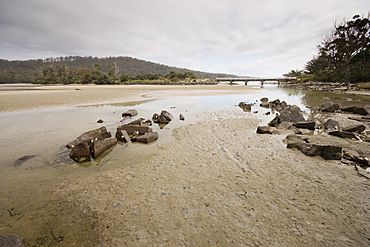Cockle Creek (Tasmania) facts for kids
Quick facts for kids Cockle CreekTasmania |
|
|---|---|
 |
|
| Location | 148 km (92 mi) SSW of Hobart |
| LGA(s) | Huon Valley Council |
| State electorate(s) | Franklin |
| Federal Division(s) | Franklin |
Cockle Creek is an amazing place in Tasmania, Australia. It's special because it's the farthest south you can drive on the whole continent! It sits right on Recherche Bay, next to the huge Southwest National Park. This park is part of the Tasmanian Wilderness, which is a special World Heritage Area.
Don't expect shops or big buildings here! Cockle Creek is mostly wild. There's a campground in the National Park with toilets and a public phone. Park rangers are sometimes there to help. People love coming here for camping, fishing, birdwatching, and bushwalking.
Did you know artists can even stay here? Arts Tasmania and the Tasmania Parks and Wildlife Service have a program. Artists can live at Cockle Creek to create art inspired by Tasmania's beautiful nature.
Contents
Exploring Cockle Creek
This area is famous for its stunning white beaches and clear blue waters. You can find many different types of plants here. There are tea tree bushes, tall eucalyptus trees, and open healthland.
Fun Activities
- Short Walks: A quick 5-minute walk from the car park leads to a bronze sculpture. It shows a baby southern right whale. Signs explain the area's history, like how people used to hunt whales, cut timber, and mine coal.
- Longer Adventures: You can walk to the Fishers Point Navigation Light. You'll see old ruins of a Pilot Station there. Another path goes to South East Cape. From here, you get amazing cliff-top views of the Southern Ocean and Maatsuyker Island.
- Challenging Hikes: For experienced hikers, Cockle Creek is the end point of the 82-kilometer South Coast Track. This long trail is for people ready for a true wilderness adventure.
A Look Back in Time
Early History and Indigenous People
Long ago, Tasmanian Indigenous People lived in this region. They valued it for its seals, shellfish, and hunting. They would visit during the warmer months. You can still find evidence of their past, like shell middens (piles of shells).
European Explorers Arrive
In 1792, a French explorer named Bruni D'Entrecasteaux sailed his ships, the Recherche and Esperance, into Recherche Bay. He came back in 1793. His trip was for science and to study plants. He named the bay after one of his ships. In 2003, people found the remains of a garden the French had planted! A special area was made to protect it. Other old sites from his trip have also been found.
Whaling and Timber Days
Cockle Creek became an important stop for ships. These ships carried convicts to the Sarah Island Penal Colony from 1822 to 1834. During the 1830s, sealers, whalers, and loggers came here. They settled to get Huon pine timber or to hunt whales in Recherche Bay. At one point, there were four whaling stations at Cockle Creek.
In 1836, a pilot station was set up at Fisher's Point. This helped guide ships into the bay. But it was closed by 1851. By the 1840s, seven whaling stations were operating in the bay. Whales, especially sperm whales and southern right whales, were hunted a lot. Sadly, this included pregnant whales and their calves. By the 1850s, bay whaling started to decline. There were fewer whales, and deep-sea whaling became more common.
A Bustling Settlement
At its busiest, Cockle Creek had over 2,000 people! There were even plans for a town called Ramsgate. As whaling slowed down, cutting timber became very important. Wooden tramways were built to move logs to sawmills. Later, coal was found. The tramways then carried coal to ships for export. But eventually, the coal ran out, and people began to leave.
Images for kids




